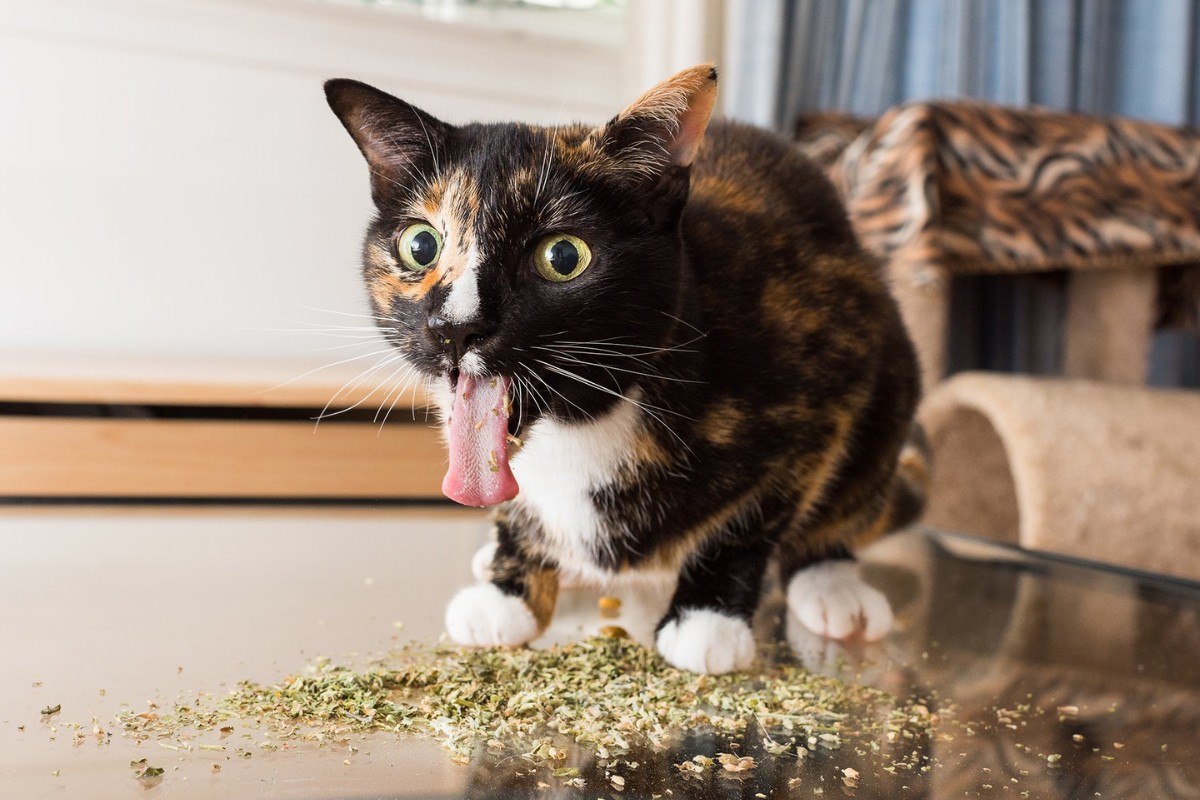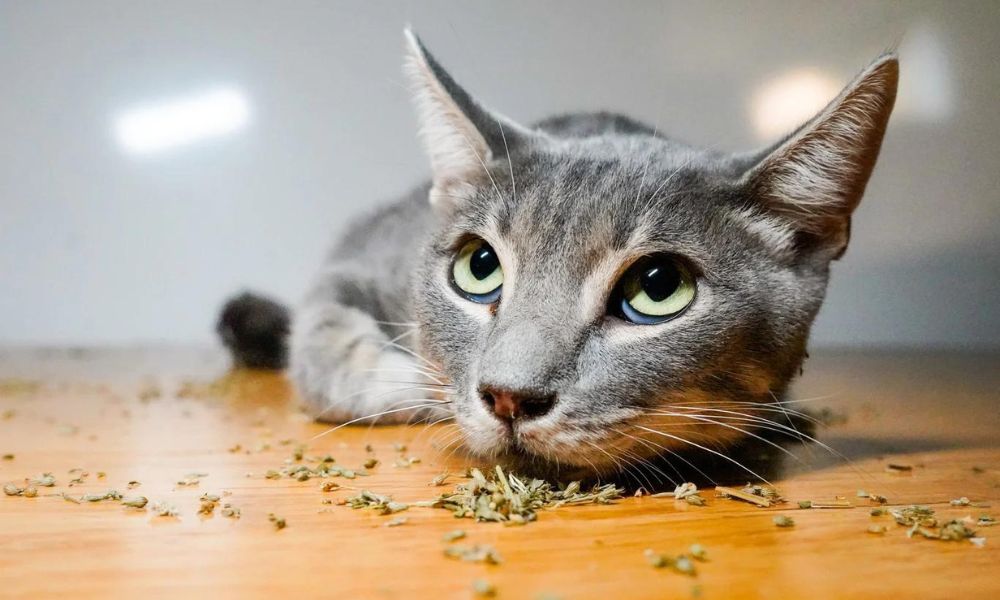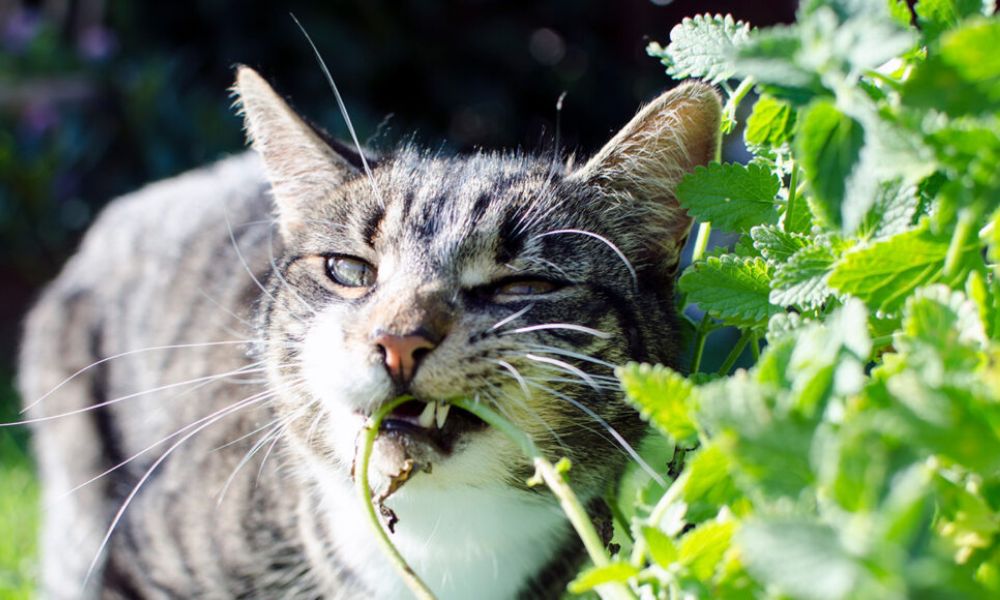 3 Nov
3 NovCan Cats Become Addicted To Catnip? (Explained)
We will be addressing a topic that tickles the curiosity of many cat owners: the enigma of cats and their often-entertaining reactions to catnip. It’s a scene we’ve all witnessed — a normally composed cat encountering a sprinkle of this herb, then transforming into an embodiment of joy and silliness. But it begs the question: Can our kitty companions actually develop an addiction to catnip?
No, cats cannot become addicted to catnip in the way humans can become addicted to substances. Catnip induces a temporary state of bliss in felines, but it does not cause the compulsive need to use that characterizes addiction. The active ingredient in catnip, nepetalactone, triggers a sensory response in cats that mimics feline “happy” pheromones.
However, the effect is short-lived, usually lasting for about 10 minutes, after which the cat loses interest and will not respond to the herb again for at least an hour. Cats enjoy the effects of catnip, but they do not display the signs of addiction or withdrawal when they do not have access to it, indicating that catnip is not addictive for cats.
Many of us have chuckled at the sight of our four-legged friends blissfully rolling in a patch of catnip or fervently batting at a toy stuffed with aromatic leaves. Despite the widespread amusement catnip provides, it’s crucial to peel back the layers of laughter to understand what’s truly happening with our cats and their green treat.
As an experienced cat parent with a penchant for feline welfare, I’m here to share insights, clear up common misconceptions, and explore the realities of catnip’s effects on our furry family members. So, let’s get right into it — sans fluff, with the straight facts — and examine whether the allure of catnip could ever cross the line into feline addiction.

What is Catnip?
Catnip, scientifically known as Nepeta cataria, is a perennial herb belonging to the mint family. It’s native to Europe and Asia, but these days you’ll find it flourishing worldwide, especially in places where cat lovers dwell. With its heart-shaped, serrated leaves and whorls of white or pale purple flowers, catnip isn’t just another pretty plant. It has a storied history of use, from traditional herbal remedies for humans to a stimulant for cats.
The magic of catnip lies in a volatile oil found in its leaves and stems, with nepetalactone being the star compound responsible for the effects on cats. This organic compound is a terpenoid, which means it’s part of a large class of chemicals that plants often use for defense. In catnip’s case, nepetalactone serves as an attractant to cats but a repellent to insects.
When a cat gets a whiff of nepetalactone, it binds to the olfactory receptors in their nose, which then sends signals to the brain, particularly the amygdala and hypothalamus. These areas of the brain are associated with emotions and responses to stimuli.
Cats exhibit a range of behaviors: from rolling, pawing, and flipping to mellow relaxing. Biologically, the reaction is akin to how female cats respond to male pheromones during courtship. It’s a blend of behavioral responses to natural pheromones.
Can Cats Become Addicted to Catnip?
When we talk about addiction in the context of human behavior, we’re referring to a chronic disease characterized by the compulsive seeking and use of a substance, despite harmful consequences and changes in the brain that can be long-lasting. Addiction involves a psychological and physical inability to stop consuming a chemical, drug, activity, or substance, even though it is causing psychological and physical harm.
In contrast, a cat’s response to catnip is a natural, instinctual reaction to the nepetalactone compound in the plant. This reaction is not an addiction; it’s more akin to a temporary state of happiness or euphoria. After exposure to catnip, cats typically return to their normal behavior without showing signs of withdrawal or distress that would indicate an addiction. There’s no evidence to suggest that cats develop a dependency on catnip or that it impacts their brain chemistry in the way addictive substances affect humans.
Veterinarians and feline behaviorists consistently observe that catnip does not lead to addiction in cats. According to experts, catnip use doesn’t result in the destructive behaviors associated with addiction, nor does it affect a cat’s health negatively when used in moderation. Cats may enjoy the sensation catnip provides, but it doesn’t compel them to seek out the herb obsessively.C. Differences between enjoyment and dependency.
Health Benefits and Concerns
Possible health benefits of catnip for cats
Catnip isn’t just about fun and games; it may have several health benefits for cats. Its most straightforward advantage is the way it encourages play, which can help keep a cat physically active and reduce stress. Engaging with catnip can provide a burst of energy for play, which is excellent for weight control and overall health, especially in indoor cats that may have fewer opportunities for exercise.
Additionally, the herb can act as a mild sedative when eaten, which may help soothe cats in stressful situations, like visits to the vet or adjusting to a new home. For cats that become anxious or depressed, catnip can serve as a natural way to stimulate activity and improve mood.
When Catnip Can Become a Concern – Signs to Watch For
While catnip is generally safe for cats, it’s possible for them to enjoy it a bit too much. Overindulgence can lead to mild digestive upset, which might manifest as vomiting or diarrhea. If a cat consumes a large amount of catnip, it might experience mild tummy trouble.
Furthermore, if a cat reacts with extreme excitement to catnip, this could potentially lead to aggressive play or accidental harm to themselves or other pets. Signs to watch out for include changes in behavior, gastrointestinal upset, or lack of interest in food following catnip exposure.
Recommendations from Veterinarians
Most veterinarians agree that catnip is safe for cats and can be a healthy part of their routine. The general recommendation is to offer catnip in moderation — typically a few times a week — to keep it special and prevent potential overstimulation. It’s advised to provide catnip as a reward or as a means to encourage exercise and enrichment.
For cats with health issues or sensitive stomachs, it’s always best to consult with a veterinarian before introducing new elements like catnip into their regimen. If your cat has a history of epilepsy or other neurological disorders, it’s crucial to speak with your vet, as catnip can sometimes trigger seizures in predisposed animals.
Using catnip responsibly means ensuring it’s fresh and free of pesticides, and observing your cat’s behavior during and after its use. If you notice any adverse reactions, it’s wise to discontinue use and consult your veterinarian. As with any treat or supplement, what works for one cat may not be suitable for another, so individualized care is key.

Responsible Catnip Use
Guidelines for offering catnip to your cat
To ensure that your cat enjoys catnip responsibly and safely, here are some simple guidelines to follow:
- Introduce Gradually: Begin by offering a small amount of catnip to observe how your cat reacts. Not all cats are affected by catnip, and responses can vary.
- Quality Control: Only provide high-quality, organic catnip that is free from pesticides or additives that could harm your cat.
- Supervised Sessions: Monitor your cat during catnip play to ensure they do not ingest too much or exhibit any adverse reactions.
- Controlled Environment: Offer catnip in a safe area where your cat can’t harm itself if it becomes overly excited.
- Right Timing: Use catnip as a treat or to encourage exercise. Avoid times when your cat needs to be calm, such as before a vet visit.
How often should cats be exposed to catnip?
The frequency of catnip exposure should be moderated to prevent desensitization and to keep it a special treat for your cat:
- Occasional Treat: Offering catnip once a week is a good rule of thumb for most cats.
- Special Occasions: Use catnip to celebrate your cat’s birthday or adoption anniversary, or to help them adjust to a new environment.
- Monitor Behavior: If your cat seems less responsive to catnip over time, it’s a sign to cut back on frequency to allow their sensitivity to reset.
By using catnip responsibly, you can ensure it remains an enjoyable and stimulating treat for your feline friend. Always keep your cat’s health and personality in mind when determining the right amount and frequency of catnip use.
Alternatives to Catnip
While catnip can be a delightful treat for many felines, it’s not the only option for those looking to provide their pets with stimulation or relaxation. Whether your cat is one of the few that don’t respond to catnip or you’re simply seeking variety, consider these alternatives:
- Silver Vine (Actinidia polygama): This plant contains two attractant compounds and is known to elicit a similar, sometimes stronger, reaction compared to catnip. It’s a great alternative, particularly for cats that don’t respond to catnip.
- Valerian Root: This herb has a compound called actinidine, which has a similar effect to nepetalactone in catnip. Valerian can act as a stimulant for cats, but it’s also renowned for its sedative properties in humans.
- Tatarian Honeysuckle (Lonicera tatarica): Some cats who are indifferent to catnip may enjoy the wood from this species of honeysuckle. It can be a good choice for cats that are more inclined to chew rather than sniff or roll.
- Lemongrass: This herb has a scent similar to catnip and can have a mild effect on cats. However, it should be used sparingly and with caution, as it can cause gastrointestinal upset if ingested in large amounts.
Activities and toys to engage your cat’s senses without catnip
- Interactive Toys: Puzzle feeders, laser pointers, and interactive toys can keep your cat’s body and mind engaged. These toys tap into your cat’s predatory instincts and provide mental stimulation.
- Physical Exercise: Regular play sessions with toys like wands, feathers, or balls help keep your cat active and can be an excellent substitute for the excitement catnip provides.
- Sensory Enrichment: Providing a variety of textures, scents, and sounds can enrich your cat’s environment. Scratch posts, plush beds, or toys with bells and crinkles can offer sensory stimulation.
- Training: Yes, cats can be trained! Using clicker training or other positive reinforcement methods can be a fun and rewarding way to bond with your cat and keep their mind sharp.
- Cat-Safe Plants: Having cat-friendly plants around for your cat to nibble on can provide them with a sensory experience. Wheatgrass, for instance, is a popular choice.
Remember, each cat is unique, and their preferences can vary widely. It might take some experimentation to find out what your cat enjoys the most. The key is to offer these alternatives in a safe, controlled manner, always under supervision, to ensure your cat’s safety and enjoyment.




